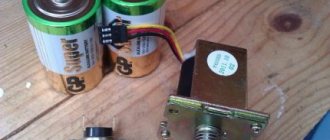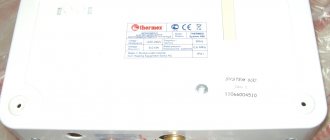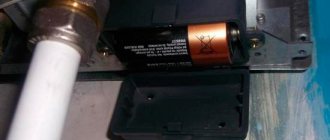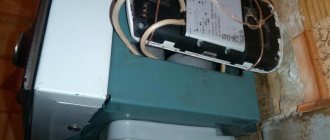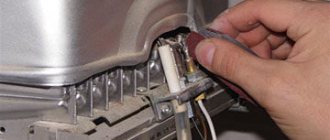07.09.2018
To satisfy consumer needs for hot water, many water heating devices, both electric and gas, have been developed. For reliable operation, they are equipped with new control and protection systems for safe and long-term operation. But no matter how reliable water heaters are, over time they also fail. Repair of geysers, as a rule, should be carried out by professionals, but in some cases it is possible to troubleshoot problems yourself.
The geyser is a fairly unpretentious device to operate and can operate for a long time without breakdowns. But if they happen, then you can diagnose the geyser for proper repair of the device using the following signs:
- power problems;
- water unit malfunction;
- problems with the gas block;
- incorrect installation.
If problems are discovered in the gas block, then you cannot repair the Ariston gas water heater or repair the Junkers gas water heater, as well as any other water heater yourself. The breakdown must be corrected by a qualified technician. In other cases, you can try to cope on your own.
Power problems
For normal operation of most components inside the unit, a stable power supply is required. Therefore, if malfunctions of the geyser appear in the form of malfunctions, which are characterized by the fact that the flame does not ignite or goes out during operation of the device, then a possible cause of such a problem may be a lack of current power
supplied from batteries.
This does not apply to units without electronic components in the design. For example, you will not find it in the Neva 3208 unit, which you want to repair, or when repairing an old model Astra gas water heater.
Often, when repairing an Oasis gas water heater, as well as a Junkers gas water heater, users are misled by the fact that the LCD display lights up and there seem to be no problems with power supply. But it should be borne in mind that ignition requires a sufficient charge to form a spark in the spark plug. In addition to this, the electronic unit also requires power to transmit it to the solenoid valve in order for it to be in the “open” state. Therefore, if the batteries are already low, then there may not be enough power to ensure the operation of these modules.
In the instructions for the water heater, the manufacturer indicates the operating time of one set of batteries. As you might guess, this value is approximate, and it depends on the quality of the batteries used. When purchasing batteries, you should pay attention to the markings on them. For long-term operation of the gas water heater, it is recommended to choose batteries marked LR20
. This means that they are alkaline, that is, alkaline.
Cheaper ones, labeled R20, fail very quickly and cannot cope with a constant load. The ideal option is CR20 lithium batteries. Their main difference from alkaline ones is their high capacity, stable current generated, and long-term operation, several times longer than the service life of LR20 batteries. The only drawback of batteries marked CR20 is their high cost.
. So, buying LR20 alkaline batteries will be the right choice in terms of efficiency and cost-effectiveness.
Remember: never buy batteries from street kiosks, much less from trays in the market. This recommendation especially applies to the winter period, since the cold causes the batteries to lose their charge.
What to do if the piece constantly clicks on its own
The most important thing in such a situation is to find the source of the problem, and then simply follow the instructions for eliminating it. If you discover a breakdown, do not panic and strictly follow all safety rules, try to make repairs, guided by our advice. Remember - most of the causes of the problem, in this case, are absolutely safe and can be eliminated independently, without resorting to the services of specialists.
How to fix the problem without the help of a specialist
The following actions can help in dealing with the malfunction:
- If the cause of the breakdown is water, and its constant contact with the stove, then there is only one way out - dry it thoroughly, first turning off the auto-ignition from the outlet. Let the stove stand unconnected to the power supply for several days - during this time it should dry thoroughly and the clicking will stop on its own. If such a “repair” does not help, it’s time to call a specialist and entrust the repair to him. When drying, one important point must be taken into account - you cannot dry the stove using a working oven - otherwise moisture, on the contrary, will accumulate in the appliance in huge quantities and the situation will only worsen. Therefore, be patient and let the device dry naturally.
- If the ignition button does not work well, the reason is the accumulation of dirt, dust or congealed grease under it. Clean it. For better cleaning effect, use a brush dipped in soapy water. After cleaning, let the stove dry. It should be noted that this method is not always able to return the button to its previous functionality. There is always a possibility that due to the low landing, it will not press completely. If cleaning does not help, consider replacing the auto-ignition button or its entire mechanism.
During prolonged use, the auto-ignition unit may fail. If only one burner does not work, then the reason is most likely due to damage to the wire located in the channel of the block. But do not forget that the burner itself may also be faulty, and in this situation, independent repair is not only unacceptable, but life-threatening. To accurately diagnose the cause of a non-functioning burner, you should contact a specialist who can not only identify the actual cause of the malfunction, but also replace the damaged element.
The main thing is that no matter what happens to your favorite stove, do not panic and act thoughtfully. Remember, thoughtful repairs can fix almost any damage.
Household appliances Stove
Removing the column lining
Repairing a geyser with your own hands, such as replacing batteries, is the only way to troubleshoot problems that does not require removing the outer casing of the unit. To repair geysers Vector, Oasis and any other malfunctions, you will need to open the device. To begin removing the casing from the water heater, you need to turn off all the water and gas supply valves, and then do the following (for example, we take the Neva 5611 water heater, which we will disassemble on the table).
Internal breakdowns
If the reason is in the column, then you need to figure out what it could be? There are two reasons: either the filters are clogged or the membrane is deformed . If the water is too hard, then the water supply pipes may become clogged, as well as the filters that are additionally installed in various models of geysers. Due to lime or other deposits, the metal filter grid, which is installed on the pipe in front of the water supply unit, may become clogged. To restore normal operation of the column, you need to clean or completely replace the filter in the mixer.
The cause of the malfunction may also be the filter in the mixer.
To do this, you just need to unscrew the nuts and see how serious the contamination is. If there are a lot of lime deposits, then it will be easier to buy a new filter. If there is a small amount of lime deposits, then you can clean the filter using special detergents or traditional methods. As practice shows, cleaning is quite simple, you just need to work a little. Also, you need to clean the column from soot and other combustion processes.
If this does not help, then you need to examine the membrane of the water block of the column . It is located inside the column itself, to get there you will need to unscrew the bolts holding the column cover. Inspect the rubber membrane; it should be free of visible cracks and breaks, and of the correct shape. If it is deformed or damaged, it must be replaced. It is better to purchase a new silicone-based membrane. Silicone gives the membrane a more resistant surface; such a membrane will be more resistant to temperature changes, more elastic and will last much longer.
The membrane must be installed carefully so as not to damage it during installation. The fastening screws must be tightened not all in order, but in opposite directions, gradually squeezing the lid with it. All these procedures can be done independently, but it will be safer to call a specialist who will comprehensively clean the column of all contaminants and assess the condition of the entire unit, and perhaps identify other faults.
There are times when a gas water heater goes out. The main reason for this event is that the pressure of cold water is stronger than hot water. It is better to adjust the hot water supply temperature to a comfortable temperature so that you do not have to dilute it with cold water. Turning on cold water while the column is on not only leads to the column going out, but is also considered improper operation of this unit, which can lead to its rapid breakdown.
Also, the water heater may go out when turned on, this may be due to the fact that you did not hold the ignition button long enough . On average, you need to hold this button for at least twenty seconds; if you hold it for less, the speaker immediately goes out. Also, it may go out due to a malfunction of the exhaust gas sensor. To check whether the sensor is working, you need to ring it by connecting both of its terminals; its resistance must be equal to infinity. If not, replace the sensor.
Water unit malfunction
Most often, geyser repairs are made due to a faulty water block. Its work is that, under the influence of liquid pressure, the membrane located inside it, arching, transmits movement to the rod, and it then moves the pusher of the gas unit. As a result, the spring valve opens and the electrical power supply to the control module is turned on. Therefore, if the water unit is faulty, the device will not start.
A broken water block can be determined by external signs.
.
If you notice even one sign, the unit will need to be removed and repaired. The water unit can only be removed together with the gas module, since they are a single structure. You can do this in the following way:
- after you have made sure that the gas valve on the pipe is in the closed state, you can disconnect the supply hose (a);
- similarly, when the water supply is turned off, the nut on the water block pipe (b) is unscrewed;
- then, using a wrench, you need to unscrew the nut that connects the water block to the heat exchanger (c);
- disconnect the terminal block (d) on the conductors connecting the solenoid valve to the control module;
- wires (d) going to the switch are disconnected in the same way;
- using a screwdriver, you need to unscrew the 2 screws (e) attaching the pipe to the water-gas unit, through which fuel is supplied to the burner manifold;
- After unscrewing the fasteners, the entire assembly can be easily removed from the device.
Repairing a Neva 3208 gas water heater due to a faulty “frog” is similar and intuitive, although the internal appearance of the unit is slightly different. The Neva 4511 gas water heater can be disassembled in the same way, and repairing it yourself is quite feasible.
a Chinese gas water heater repaired?
, the size of the water node is always surprising. It is quite small in size, and to disassemble the “frog” you only need to unscrew 4 screws.
What problems do you often encounter with gas stoves?
Some popular problems in the performance of the device that are significant are highlighted. Their repairs should only be carried out by specialists. These problems include:
Gas flows poorly to the burner or is absent altogether. Usually this problem is not affected even by fully opening the tap, since in any case there is an extremely weak flame, and often there is no flame at all. For repairs, you have to remove the burner, in which the nipple is cleaned. If this does not lead to the desired results, you have to turn to gas workers. The plug turns tightly. Also, when it returns to place, there is no special click, so the pin does not fit into the corresponding recess. Usually the reason here is that the lubricant used for this element thickens, so turning the plug becomes difficult and tight. Also, the recess often becomes clogged with various products or oils. Here you will have to disassemble the tap, and the general flow of gas will certainly be blocked. To remove the tap, the handles and decorative panel are dismantled. Next, the pins will open, which act as a holder for the plugs in a special protective housing. All parts are removed and thoroughly cleaned in a special solution. Then they are dried and inserted into place. Since you have to work with complex elements in a gas stove, it is best to entrust the process to specialists. An unpleasant smell of gas appears during operation of the equipment.
In this case, it is important to completely stop any activities with the gas stove and contact a gas specialist.
Thus, problems with gas stoves are considered quite frequent and popular. Some of them are complex and specific, so they must be trusted to specialists
Simple and standard problems can be solved on their own, for which it is important to know the cause of the breakdown, which can be easily eliminated, after which the ease of using gas equipment for its intended purpose is ensured
Heat exchanger repair
Repair of the geyser heat exchanger will be required in the following cases:
- if insufficient water pressure is noticed at the outlet of the gas water heater;
- low heating of the liquid;
- Noises are heard when the unit is operating.
The reason for all this may be scale
, formed on the inner surface of copper tubes.
Therefore, the heat transfer and throughput of the latter are reduced. In addition, if the unit has not been serviced for a long time, dust and soot
, which also interferes with the water heating process. The heat exchanger is easy to remove.
Repair of heat exchangers of any geysers begins with washing them under a strong stream of water to remove dust and other contaminants. After which it is recommended to immerse it in water for half an hour with the addition of detergent, for example, for dishes.
Cleaning of the unit continues with a small, soft brush, after which it is washed again under running water. Water heater tubes clogged with scale are cleaned with a strong flow of water in the opposite direction. If the scale is not completely removed, you will have to pour a special acid solution
. To prepare it, you can use regular citric acid. You need to take 100 g of acid and dilute it in 1 liter of water heated to 40C. This solution is poured into the heat exchanger pipe until it emerges from the other. The reaction will be immediately visible in the form of escaping foam. The poured solution is left for 15 minutes, after which all channels of the unit are thoroughly washed under water pressure.
If you are not satisfied with the result, dissolving the scale can be repeated.
In this way, the heat exchanger of the gas water heater Neva Lux, Dion, KGI, Selena, as well as the gas water heater Neva Transit is washed.
Installation of a gas stove with electric ignition
Darina, Hansa, Ardo – so different and at the same time the same. The repair of gas stoves by Hephaestus is exactly like the repair of Ariston; gas stoves are made up of standard units. It is enough to look at a single device to understand the circuit. Have a reference book to help you properly maintain gas pressure. When set correctly, the flame is even and blue. Orange flashes indicate an imbalance in the fuel mixture. If the settings are incorrect, the flame will fail (especially typical for carob ovens).
For those who have read the reviews of the VashTekhnik portal regarding gas instantaneous water heaters, independent repair of gas stoves will seem like child’s play! You cannot do it yourself, but you can clean the device. The technician will have to clean candles, combustion sensors, burners, and sometimes nozzles. There are a lot of interesting things inside the gas stove. Anyone learning how to properly clean equipment should understand what we will see inside. Under the gas stove table:
- Burners. They are often bolted to the gas stove table. Each burner consists of a lid, a divider, and an injector (nozzle). They are not rigidly fastened under the table; each is fitted with a steel or copper tube; the fastening is carried out like an American one. You will need a key of approximately 13 to remove the products. It is more convenient to clean if something is clogged inside. Beware of tearing off the head or thread - you will have to replace it. After assembly, check the tightness by washing. The procedure involves applying foam to the disputed nodes.
- There are two candles around the perimeter of the burner. One serves as ignition (due to a piezoelectric element or an electronic circuit), the second is a thermocouple, included in the combustion control circuit. It's quite easy to distinguish. The high-voltage spark plug is covered with a ceramic caftan so that the spark does not strike below a predetermined level. When the arc flows, you can see: the tongue of the discharge licks the body of the burner. Gas stoves with electric ignition will be properly grounded by a technician. Beware of using plumbing connections or connectors pierced with metal threads. During installation, the hoses are separated from the riser by special gaskets. Failure to follow the rule will easily provoke an explosion in favorable situations. We wrote in more detail, we remind you again. The candle with a thermocouple is covered with a bronze caftan that conducts heat. The faster the semiconductors cool down, the flame goes out, and the protection that cuts off the gas supply will work more reliably.
- Most often there is a collector under the table. A thick tube from which a line goes to any burner. The gas flow is controlled by solenoid valves. The number is usually equal to the number of burners. When the burner flame goes out, the rest will burn. The expediency of the decision can be challenged, but this is how it is done. Each solenoid valve contains an inductor. The thermocouple heats up, an EMF (tens of millivolts) appears, keeping the devices open. Complete activation procedure: turn the gas supply regulator, press down. We press the piezo ignition button, or the electronic circuit performs a set of procedures independently. We hold the handle for a fixed time. The thermocouple warms up, an EMF begins to be generated, the electromagnetic valve is held open due to the phenomenon discovered by Seebeck. As soon as the gas goes out, the sensor plug cools down and the gas supply stops. The process is inertial, we believe that the day is not far off, flame ionization sensors will begin to be used in gas stoves, allowing the protection to operate instantly.
- Similar to the gas manifold, there is a distribution valve panel inside. Single high-voltage wires run to each ignition electrode. Another way to distinguish a thermocouple: two wires with a thinner cross-section stretch to the sensor. The spark breakdown goes to the housing, the second ignition wire is superfluous. If the gas stove is deprived of grounding, we have a chance of getting an electric shock. Fatalities are possible - an additional reason to entrust the installation to a professional. The collector is connected via connectors. There is protection against incorrect orientation of the plug; you can easily mix up some places. When you open the burner, a spark will jump on another divider. It’s not very pleasant, a flash of flame is possible.
If the charge is generated by an electronic circuit, you will find a simple thyristor, diode, capacitor, and fuses inside. The circuit operates, powered by a capacitor charge with a subsequent burst of energy from the spark gap of the spark plug. Repair of electric ignition of a gas stove concerns the listed elements. The fault is easy to notice. Burnt elements are black or similar in color.
Incorrect installation
The reason that the water heater turns off after starting may be due to its incorrect installation. The diagram below shows how the unit should be installed.
The following pictures show common mistakes when installing a water heater.
Such installation methods disrupt normal draft, as a result of which the operation of the water heater becomes incorrect, and in some cases, impossible.
Gas water heaters in everyday life are becoming an indispensable thing both in private apartments and in country houses and ordinary dachas. Manufacturers of geysers nowadays make a good and inexpensive product from our manufacturer, since today the market is in full swing and competition is very high.
Oasis geysers are popular heating devices among consumers. These models are inexpensive designs. They include economy, reasonable price and popularity. You can also read a lot of positive reviews about the Oasis geyser, which speaks volumes about their quality.
In order to choose the right model for your home, you should pay attention not only to their advantages, but also to the weaknesses of the heating device. We also recommend that you pay attention when choosing to customer reviews of Oasis geysers.
Requirements for a stove with electric ignition
A stove with electric ignition must be connected to the network. And for this you need a grounded outlet. If it is not nearby, separate wiring is done. In this case, the wire must be three-core and with a cross-section of at least 1.5 mm in diameter. In parallel, the electrical panel must be equipped with a 16A protection element. It can be an RCD or differential, or a regular machine. As for the cord itself, it is usually included with gas stoves with electric ignition by default. If it is missing, it is made independently, using a three-core wire of suitable cross-section and a plug with grounding contacts. But you can buy it.
There are two main options for installing a differential machine. It is installed alone for the entire electrical network, or several products are installed, one for each individual line. It is possible to install a differential circuit breaker during selective installation not on every line, but only where it is necessary to ensure the safety of people in the event of possible contact with live parts of electrical equipment. In this case, you need to be guided by the main rule for installing difavtomats - this should only be done by a specialist.
Instructions
Check the installed device for damage and cracks in accordance with the requirements of the Installation Rules. This must be done, since in the presence of these malfunctions, full protection will not be provided. These rules apply to all such devices without exception. You should carefully check the proper operation of the device’s activation mechanism and the corresponding markings on the product body. Differential circuit breakers and RCDs (residual current devices) are almost identical products, so they are connected in the same way.
Install the differential circuit breaker in the electrical panel on a DIN rail. The principle of its operation: it compares the electric current passing through the phase conductor with the current passing through the neutral conductor. Their value is usually the same if the device is in working order and the insulation of the electrical wiring is not damaged. If a leakage current occurs in the circuit, their value will become different. The difavtomat will instantly detect these changes and compare the level of leakage current with the rated value provided for this device. When the leakage current readings exceed the rated value, the machine will turn off the power to this section of the electrical network. It is possible to turn on the power supply again only after troubleshooting.
Connect two wires to the differential machine - neutral and phase for a 220 V network, or three phase and one neutral for a 380 V network. A differential machine differs from an RCD in that it not only protects a person from electric shock, but also automatically disconnects any section of the network in in case of overload or short circuit. It has built-in overcurrent protection, which is not present in the RCD. According to regulatory regulations, it is recommended to install only differential circuit breakers. It is strictly forbidden to install ordinary RCDs in group lines, unless there is an additional device responsible for protection against short circuits and overloads. There are separate regulations for installing these devices in residential premises. Only type “A” residual current devices that respond to pulsating and alternating fault currents are allowed for installation. You can also install RCDs of the “AC” type, which respond only to alternating leakage currents.
Video on the topic
On many models of gas stoves, designers install automatic ignition, which is turned on with the gas supply or from a separate button. This function is very convenient: you do not need to come into contact with an open flame in order to light the burner. If you suddenly discover that the automatic ignition on a gas stove does not work, do not rush to call the service: it is quite possible to repair this malfunction yourself.
Common problems
Let's look at what breakdowns occur with household gas instantaneous water heaters. These breakdowns are typical for water heaters Neva, Oasis, etc.
If the water heater does not light up
There is no need to sound the alarm right away. Some problems are not very serious. With these problems, the water heater may make a popping noise when turned on.
Lack of traction
There is no draft in the exhaust duct. Maybe some object got in there and blocked the exhaust duct.
Or maybe there are a lot of combustion products in this channel - soot - and it is clogged. The circuit breaker tripped and the column stopped working. We need to check for traction. Bring a match to the ventilation; if there is draft, the flame will be directed towards the channel. If there is no draft, then you need to call a chimney sweep and clean the channel.
You may not be able to get by with cleaning just one channel. Some of the soot accumulates on the column itself, so you can vacuum the column to remove it.
In the absence of the necessary draft, the water heater may turn on, work a little and go out. Try opening a window to increase the amount of air.
Old batteries
Another reason why the water heater does not turn on is that the battery life has expired, the batteries in the electronic device have simply run out. Change them and the problem will be fixed.
Weak water pressure
Maybe there is insufficient cold water pressure. This is easy to check by opening the water tap. If the cold water pressure is low, you need to call the management company and find out the reason.
The shower is clogged
The following reason may arise: there is hot water pressure in the tap, but when you switch to the shower, it stops flowing. Check to see if the shower itself is clogged.
The water heater does not heat water or does not heat water well
Most likely this is a water node problem. There is a rubber membrane there, which for some reason stops responding to water pressure, which, in turn, leads to the gas supply being cut off. There may be a crack in the membrane, salt deposits may have accumulated due to hard water, or it may simply be clogged.
The assembly must be disassembled, the membrane cleaned or replaced, it is better to replace it with silicone. It is also possible that the coarse filter installed in the water unit is clogged.
Column clogged
The water may not heat well due to a clog in the column itself. This is indicated by the soot that forms above it and the changed color of the gas.
Repair
Low power
Your speaker may have low power, so carefully read the characteristics of your unit.
Weak gas pressure
Water will not heat up well if the gas pressure is low. In this case, call the gas service.
The water is very hot
This is not a breakdown of your unit. You just need to reduce the gas supply, turn the tap located on the gas pipe in front of the column.
Smell of gas
If you suddenly smell gas, you shouldn’t deal with this problem yourself. Call the gas service immediately. There should be no gas smell. Also, if, when you turn on the column, the characteristic sound of gas turning on does not follow, that is, gas does not flow, you should contact specialists, gas workers.
Why does the speaker turn off during operation?
If the gas water heater lights up normally, but for some reason goes out during operation, this may indicate that the device’s security system is functioning properly.
The column design has a sensor that is triggered when the internal temperature rises. There are two plates inside the system that repel each other, stop the power supply, and turn off the column. This happens when your core temperature rises quickly and uncontrollably.
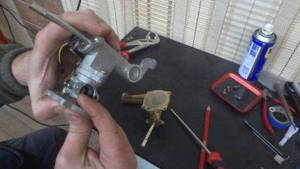
The gas water heater automation system includes three sensors: draft, flame, overheating. Plus two valves: gas and reset. They ensure safe operation of the device
You can check the sensors by resistance. A working part shows an infinity sign. When a different value is displayed, we call a technician.
If the device works for a long time and then turns off, check the settings. Sometimes users accidentally set it to turn off automatically after a certain time.
What else causes the shutdown:
- poor water or gas pressure;
- broken contact between the thermocouple and the solenoid valve (you need to clean the contacts and tighten the connections);
- oxidation of the power supply contacts, when the device clicks but does not light up.
It is also useful to check the batteries. Standard replacement of power supplies is carried out every six months. Batteries hold a charge longer.
Traction is poor or completely absent
The accumulation of combustion products is most often associated with clogging of the chimney with soot, soot, and debris. When there is no traction or it is insufficient, the work is not carried out.
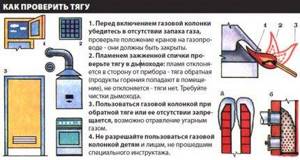
To check the draft, you need to bring a burning match or lighter to the control window of the column. If the flame deviates to the side, there is draft. It remains to burn evenly - it’s gone
It is important to remember that the flame can go out due to external factors - gusts of wind, for example. The draft in the shaft increases or decreases under the influence of a draft
You can clean the chimney through the “pocket” located 25 cm below it. If such manipulations do not help, call the utility company.
Soot accumulation on the heat exchanger
During operation, the heat exchanger accumulates soot, soot, and scale. When it becomes clogged, the color of the flame changes from yellow to blue.
How to clean the heat exchanger:
- We remove the casing.
- Unscrew the screws holding the casing.
- We turn off the water supply.
- Open the faucet to drain hot water.
- Disconnect the heat exchanger thread and tap. You will need a stand as water may leak.
- Prepare a solution of hydrochloric acid (3-5%).
- Take a pipe with a diameter of 1/2” or use a hose.
- We connect one end to the input, the other to the output.
- Pour the solution into the funnel. If foam appears when washing, this is normal.
- As soon as a strong pressure appears at the outlet, we stop the procedure.
While working, be sure to wear gloves. After descaling, you need to thoroughly rinse the heat exchanger to remove acid residues.
If during the cleaning process defects were noticed on the tubes, then the heat exchanger will have to be repaired.
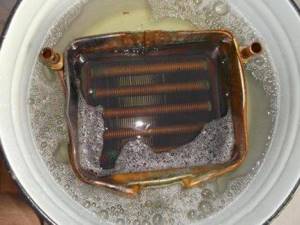
To clean the heat exchanger from scale, you can use citric acid (80 g of powder is needed for 700 ml of water). Boil the radiator in the solution for half an hour, leave until cool and rinse
It is recommended to carry out cleaning work once a year. Regular maintenance will help the device function properly.
Clogged shower head and hose
It happens that the gas water heater turns on and for some reason immediately goes out when switching to the shower. This may be due to clogged holes in the watering can.
You need to unscrew the watering can, clean and rinse the holes. Soaking metal elements in a solution of citric acid is also effective.
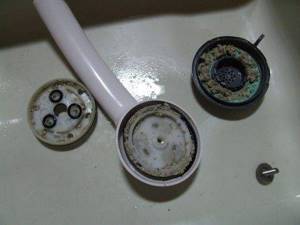
Scale on the watering can forms due to the increased hardness of tap water in some regions. To prevent this from happening, install filters or buy a faucet with a shower equipped with a built-in anti-scale system
The next part that can cause the wick to go out is the shower hose. If it gets tangled or clogged, the pressure power decreases and the column goes out.
The mixer can also break or become clogged. You need to disassemble it, check it, clean it if necessary.
At the entrance to the water supply unit there is a filter that retains small debris. It is also useful to clean it periodically. To do this, unscrew the screws, remove the element, rinse, and clean with a brush with citric acid.
Repair
If suddenly a leak appears in the instantaneous water heater, then perhaps a fistula has formed in the heat exchanger. If you want to do the repairs yourself, you will need to disassemble the water heater. Let's consider this process using the Neva column as an example.
We begin the repair by turning off the water and gas supplies by turning off the taps.
We remove the casing. To do this, unscrew the two screws at the bottom of the rear wall. By pulling the casing towards you, you need to recess two knobs: one is a piezo igniter, the other is gas adjustment. Then lift the cover up and remove it.
This is what the heat exchanger of a Neva gas water heater looks like:
Having found a fistula, you can solder it using a soldering iron. To do this, you need to drain the water from the heat exchanger. Open the hot water tap and unscrew the nut from the cold water supply pipe. The water will drain, but not all of it. The rest must be blown out using some kind of hose, blown out with your mouth so that the remaining water comes out. The pipes can then be soldered in the usual way. Perhaps the fistula is in the place where it is adjacent to the gas water heater. In this case, you need to disassemble the entire column and remove the heat exchanger. Such repairs are much more difficult to make, since it will be necessary to disconnect the gas pipe. You don’t have to solder the heat exchanger yourself, but replace it with a new one. Watch the video for repairing the Neva water heater:
There may be a leak at the point where the geyser pipe connects to the water supply. In this case, you need to change the gasket in the union nut.
Speaker in the house
In ancient times, people heated water in stoves and carried it in buckets. Fortunately, modern plumbing has solved this problem, but even a pipeline cannot prevent a temporary lack of hot water supply in apartments. Either there are scheduled checks and there is no water for a month, then a pipe has burst and there is no one to fix it, and there is no water for a week. Fortunately, there is an excellent way out of the situation, and that is a gas water heater.
In principle, the geyser is a fairly reliable unit, unpretentious in its operation. The water heater is very convenient in rooms where the required supply of hot water is much more important than its quantity. On average, the column can heat about 10 liters of water per minute. The dispenser is subject to mandatory certification and requires periodic service monitoring and maintenance. If the unit is operated correctly and maintained only by professionals, the geyser will last a long time.
The gas instantaneous water heater has become an integral element of any home
But, like any equipment, a water heater can break down. There are times when everything seems to be working fine, but the gas heater does not light up at all or lights up but immediately goes out. Column failure can be caused by both internal and external factors. All situations need to be understood.
Descaling
Insufficient water heating can occur when scale forms inside instantaneous water heaters. This can be cleaned.
For example, the simplest instantaneous water heater Oasis, made in China, can be cleaned without disassembling or removing it from the wall. Using a circulation pump, circulate water and acetic acid for about 40 minutes to dissolve the scale. Then rinse well with running water. Another problem encountered when using the Oasis: suddenly the speaker starts to heat up and turns off after a while. Be sure to clean the chimney. And until a specialist arrives, you cannot use the column. If the draft is good, then you can disassemble the Oasis column yourself and clean the heat exchanger; this may be the reason, and you will not need additional repairs.
The designs of all modern instantaneous water heaters provide for automatic shutdown of the gas supply when the water is turned off or the chimney is clogged. Therefore, there is no need to be afraid that a gas leak will occur.
It is not uncommon for a gas water heater to fail to light; it only causes headaches and inconvenience. It would seem that this unit should make life easier for people in the absence of a centralized hot water supply, but that was not the case. Malfunctions occur almost immediately after purchase; this mainly applies to Chinese speakers.
Traction disorder
One of the reasons why the Neva gas water heater does not light up is a violation of the draft in the air duct. Most often, a foreign object entering the air duct causes the automatic protection of dispensers with an open combustion chamber to trigger.
Under normal conditions, when natural air circulation is disrupted, the protective relay reacts to a sharp increase in temperature in the outlet channel and turns off the gas supply. In this case, the device starts to work normally, but does not work for a long time. Devices with a closed combustion chamber work similarly, for example, the vektor lux eco often does not ignite because even one of the channels is blocked - either the air supply to the combustion chamber or the removal of combustion residues.
Solving the problem of why the geyser does not work in this case is quite simple - clean the air duct and ensure normal air circulation in the room. By the way, one of the reasons for the disruption of natural air circulation in the house and draft in the ventilation duct can be metal-plastic windows and tightly closing entrance doors.
A little background
So we became the “lucky” owners of one of these. Literally immediately after the purchase, the heat exchanger leaked; as it turned out, we were given a repaired return. With great difficulty, we managed to make an exchange after written claims for pre-trial settlement to the store. According to the rules of the store, exchange is not possible, but where is this stated in the law? Even sending it to a service center is not so easy: first you need to call the gas workers so that they draw up a breakdown report and certify it with seals and signatures; Give the certificate to the warranty service along with the column, where a decision on repairs will be made within three days. And we have to sit without hot water all this time!
If the seller tells you that gas equipment cannot be returned or exchanged, remember, this is a lie. In the event that you purchased a product with a manufacturing defect, you are required to replace it with a new one at your request or return the money if a similar product is not available.
After several months of operation of the second unit, a malfunction appeared: the gas water heater does not ignite. I immediately remembered the procedure that must be followed for repairs under warranty. Therefore, it was decided to repair the geyser with your own hands, or at least try.
Sources of accident
There are several reasons for burner failure, the main ones being the following factors:
1. Lack of traction.
For any model, be it Neva, Oasis or Vector, the flame goes out or does not light up due to the fact that the chimney is often clogged with dust, dirt and foreign objects. In modern equipment, in this case, a safety valve is activated, shutting off the fuel supply to the gas column automatically. This happens because combustion products are not removed in full and in accordance with technical requirements.
To verify the malfunction, you need to check the traction. To do this, open a window and bring a lit match or a sheet of paper to the pipe. If the chimney is clogged, the wind will not be felt, so the gas water heater will not light. Specialists are engaged in cleaning the combustion waste removal system
It is important not to miss this moment, as exhaust gas enters the room, which can lead to serious consequences
An ingenious way to almost NOT PAY for electricity! A cunning meter that saves electricity Pays for itself in 2 months!
Sometimes the automation is triggered when a nearby hood is on, and the flame goes out or does not appear. If the device has high power, it interferes with the removal of waste, so you should never install two units in one place, especially in small rooms.
2. Sensor malfunction.
If the pilot flame goes out, it is necessary to inspect the device that controls the exhaust of gases. To do this, disconnect the wires and check the resistance using a special device. The indicator must be indicated in the passport; if it does not reach the optimal value, the sensor will have to be replaced. The burner goes out if the thermocouple breaks down. In this case, the geyser does not ignite due to low voltage, the optimal parameter of which is 10 mV.
3. Discharged batteries.
The main function of the batteries is to keep the valve open during operation. The service life of the elements is no more than a year, so manufacturers of gas units such as Neva recommend changing batteries on time. In addition, the reason that the burner does not ignite may be a malfunction of the piezoelectric element or the power cable. It is necessary to disconnect the wires and check them for internal and external breaks. If there is still no spark, the column does not turn on, then the source of the problem is different.
4. Interior clogged.
If dirt and soot get into the gas supply tunnel from the fittings to the burner, the flame goes out or does not ignite. The injectors need to be cleaned. If the fuel pressure is not adjusted, a characteristic whistle will be heard, the flame will come off, and then it will disappear. Also, a burner of the wrong diameter can create such a malfunction. In this case, you need to adjust the gas supply or replace the elements. When aired, the gas water heater ignites, but immediately goes out. To eliminate the defect, you need to unscrew the nut on the fitting and bleed the air, then return the mount to its place, fix it and check whether the burner goes out.
5. Deformation of elements.
If the water is too hard, scale appears in the pipes, which gradually clogs the filters, so the gas unit goes out or does not turn on. The grate is removed and thoroughly cleaned. If it has become damaged due to deposits, it is better to replace it.
The membrane of the water supply unit often breaks, so the column does not turn on. To determine its condition, remove the top cover of the case. The plate should not have cracks or breaks, have the correct shape, smooth and even. In case of the slightest deformation, it will have to be replaced. It is better to choose a part made of durable and elastic material that is resistant to temperature fluctuations and the influence of scale. The membrane must be installed carefully, pressing the fasteners around the perimeter.
6. Water pressure.
As in the situation with draft, the automation blocks the gas supply; if the supply is poor, the burner goes out immediately. It is worth contacting the utility services to find out the reasons and turn off the unit until then. You can use the column only if the water pressure is normal. In private homes, pressure is increased using a compact station and regulator. If the column turns on and works normally, but the water still comes out cold, the device may not have enough power, the parameters are noted in the passport.
Here's the secret to saving water! Plumbers: You'll pay up to 50% LESS on your water bill with this faucet attachment
Troubleshooting that prevents the gas heater from igniting
There is a turbocharged gas water heater with electric ignition. When the hot water is turned on, the heater clicks, but does not light up. An electric discharge is heard and the fan turns on.
The first step is to carry out an inspection; to do this, remove the column cover. It is fastened with four bolts: two from below, two from above. We also remove the knobs for adjusting the flame, temperature, and winter-summer mode. Upon inspection, everything seems intact, the wires are not burned anywhere, water is not leaking anywhere.
The principle of operation is that when a water flow appears, the gas valve is activated, an electric discharge is created, the gas is ignited, and at the same time the fan is turned on to draw waste combustion products outside. If the water pressure is insufficient or the hood does not work, the gas goes out and the column turns off.
So, open the tap and see what happens. Water rustled through the heat exchanger tubes, the electrodes gave a discharge, the fan turned on, but the gas did not ignite. Let's check if the relay (microswitch) is working, which is activated when there is sufficient water pressure and opens the gas supply valve. To do this, turn the tap again, the relay tongue should move away.
It works, which means the pressure is sufficient for the gas water heater to operate. Now let's check the operation of the gas valve. To do this, use a screwdriver to move the same tongue away without opening the water. If there is a spark at the electrodes and the fan starts working, then the gas valve is working.
The fault was found quite quickly; the ignition electrode did not produce a spark. There are only two of them: extreme ones. The one in the center is the control one; if there is no flame, it turns off the gas supply.
Operating principle
In atmospheric water heaters, the consumer turns on the forced ignition of the igniter, the flame from which is directed towards the burner. Then he opens the hot water tap, the pressure changes, and under the influence of the membrane the main gas pipeline opens.
Gas begins to flow into the combustion chamber, which is immediately ignited by the igniter. On the front panel there is a control knob with which you can adjust the flame power. In this way, the water is heated, which passes through the coil in the heat exchanger.
The disadvantage of this design is that the pilot wick burns constantly, even when the water heater is not running. If the burner flame goes out for any reason, the combined thermocouple and valve device will shut off the gas supply.
The sensor will work in the same way if there is no draft in the chimney. This operating principle was used on all first brands of geysers. In more modern models, the fuel begins to ignite from the moment the cold water flow starts.
Such devices provide electric ignition , powered by batteries. Forced-air water heaters operate by automatically maintaining the required water temperature.
The burner is started from the electrical network or a hydraulic generator, which generates current when water moves. Further heating control is carried out automatically under the control of sensor readings that regulate the operation of the fan and the combustion process.
The membrane has deteriorated
The next reason may be deformation of the membrane of the water unit. In working condition, the membrane, due to water pressure, moves the rod, which opens the gas supply. If it is stretched or torn, the water heater will not turn on.
There are two typical layouts:
- In older models of Neva and Astra columns, the water-gas system is located vertically.
There is a gas fitting on top and a water unit on the bottom. To check the condition of the membrane, you need to disconnect the water inlet and outlet pipes and unscrew the screws on top of the water unit. After this, it is removed down. Having unscrewed eight bolts, we get to the membrane. - New models of speakers have a Chinese water-gas system. It is located horizontally. On the left is the gas part, on the right is the water part, and they are combined into a common block. The easiest way is not to try to pull it out, but to check the membrane by weight. The pipes are also disconnected and four bolts are unscrewed from the side.
Membranes are sold either separately or together with gaskets in repair kits. Repair kits contain instructions that describe what to do with all the parts. Silicone ones are considered the most reliable and durable.
After replacing the membrane, the column is assembled in the reverse order and checked.


